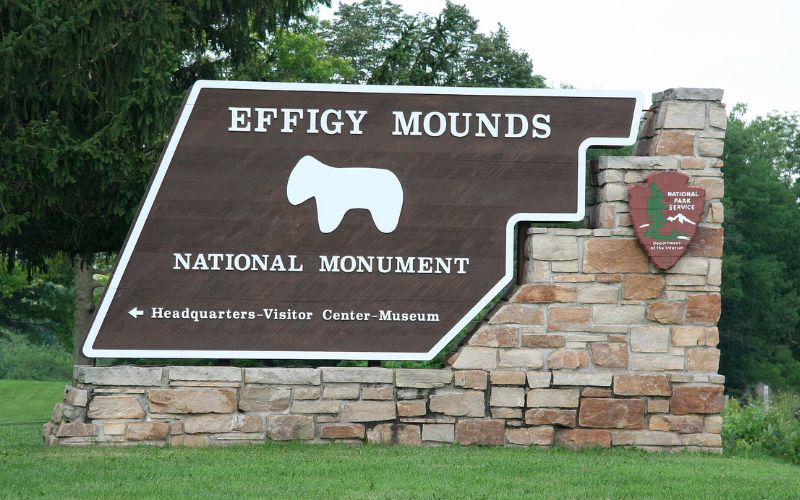
- Details
- By Kaili Berg
Recent layoffs within the National Park Service (NPS) and the U.S. Forest Service could significantly affect national parks across the country, many of which hold deep cultural and historical significance to Native American tribes.
The federal government, under the Trump administration, has announced cuts affecting approximately 3,400 employees from the U.S. Forest Service, around 10% of its workforce, and about 1,000 employees from the NPS, reducing staff by roughly 5%.
Most of those affected are probationary employees with less than a year of service, while critical positions such as firefighters and law enforcement officers are exempt. However, the broader consequences of these layoffs are already being felt in various parks, particularly those that require consistent upkeep, public education, and preservation efforts.
Effigy Mounds National Monument in Iowa is among the sites facing direct effects from layoffs. Known for its preservation of over 200 prehistoric Native American burial and ceremonial mounds, the site has been a critical location for archaeological study and historical interpretation.
Recently, two NPS employees at Effigy Mounds were laid off, including environmental educator Brian Gibbs, who played a key role in increasing public awareness of the site’s historical importance. The reduction in staff has raised concerns about the monument’s capacity to maintain its educational outreach and protect these culturally significant sites.
The layoffs will also impact operations at several major national parks and landmarks, including the Appalachian Trail, the birthplace of Martin Luther King Jr., Sequoia National Forest, and Yosemite National Park.
Yellowstone National Park, one of the most visited and historically significant parks in the country, is also experiencing staffing reductions. As the first national park in the United States, Yellowstone requires a well-maintained workforce to support its ecosystem, including geothermal features, wildlife, and historical sites.
The cuts would impact the park’s ability to provide ranger-led programs, enforce conservation efforts, and maintain trails and facilities at peak operation levels.
With fewer park rangers and educators, there is growing concern about the cultural sites and the potential loss of interpretive programs that educate visitors on the cultural significance and history of these lands.
The National Parks Conservation Association has issued a warning about the consequences of these staffing reductions.
“Visitors from around the world come to our national parks expecting a once-in-a-lifetime experience, but instead could be met with overflowing trash, uncleaned bathrooms and fewer rangers to provide guidance,” Kristen Brengel, NPCA’s Senior Vice President of Government Affairs, said in a statement. “These are not the memories we want people to take away from their experience at our parks.”
In Wrangell, Alaska, local tribal leaders have voiced concerns over the layoff’s impact on collaborative efforts with the Forest Service.
“They’re an amazing partner to us as the tribe,” Tribal Administrator Esther Aalséen Reese said in an interview with KSTK. “They’re an integral part of the fabric of our community and we’re losing people that we work with on a day-to-day basis. Literally, the Wrangell community is going to suffer by losing these wonderful individuals.”
In response, community members gathered to show solidarity with affected workers, emphasizing the broader consequences these cuts could have on Wrangell’s economy and cultural preservation efforts.
With fewer resources available, park officials will have to make difficult decisions about which services to prioritize, potentially leading to fewer educational programs, reduced access to certain areas, and slower response times on maintenance and emergency services.
More Stories Like This
Michigan Tribes Tell Supreme Court: Don’t Bail Out EnbridgeAlaskans Raise More Than $1 Million For Communities Devastated by Typhoon Halong
A True American Tale: Indigenous Rights vs. Corporate Greed
In photos: Residents of Western Alaska Share Storm Damage of Ex-Typhoon Halong
Where the Buffalo Roam: Tribes Lead Bison Return for Food Sovereignty
Help us tell the stories that could save Native languages and food traditions
At a critical moment for Indian Country, Native News Online is embarking on our most ambitious reporting project yet: "Cultivating Culture," a three-year investigation into two forces shaping Native community survival—food sovereignty and language revitalization.
The devastating impact of COVID-19 accelerated the loss of Native elders and with them, irreplaceable cultural knowledge. Yet across tribal communities, innovative leaders are fighting back, reclaiming traditional food systems and breathing new life into Native languages. These aren't just cultural preservation efforts—they're powerful pathways to community health, healing, and resilience.
Our dedicated reporting team will spend three years documenting these stories through on-the-ground reporting in 18 tribal communities, producing over 200 in-depth stories, 18 podcast episodes, and multimedia content that amplifies Indigenous voices. We'll show policymakers, funders, and allies how cultural restoration directly impacts physical and mental wellness while celebrating successful models of sovereignty and self-determination.
This isn't corporate media parachuting into Indian Country for a quick story. This is sustained, relationship-based journalism by Native reporters who understand these communities. It's "Warrior Journalism"—fearless reporting that serves the 5.5 million readers who depend on us for news that mainstream media often ignores.
We need your help right now. While we've secured partial funding, we're still $450,000 short of our three-year budget. Our immediate goal is $25,000 this month to keep this critical work moving forward—funding reporter salaries, travel to remote communities, photography, and the deep reporting these stories deserve.
Every dollar directly supports Indigenous journalists telling Indigenous stories. Whether it's $5 or $50, your contribution ensures these vital narratives of resilience, innovation, and hope don't disappear into silence.
 The stakes couldn't be higher. Native languages are being lost at an alarming rate. Food insecurity plagues many tribal communities. But solutions are emerging, and these stories need to be told.
The stakes couldn't be higher. Native languages are being lost at an alarming rate. Food insecurity plagues many tribal communities. But solutions are emerging, and these stories need to be told.
Support independent Native journalism. Fund the stories that matter.
Levi Rickert (Potawatomi), Editor & Publisher

